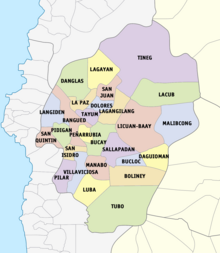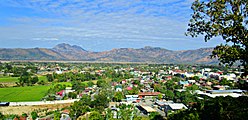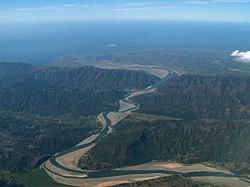
A | B | C | D | E | F | G | H | CH | I | J | K | L | M | N | O | P | Q | R | S | T | U | V | W | X | Y | Z | 0 | 1 | 2 | 3 | 4 | 5 | 6 | 7 | 8 | 9
Abra | |
|---|---|
| Province of Abra | |
(from top: left to right) Bangued, Tayum Church, Abra Provincial Capitol, Bucay Casa Real, San Quintin and Abra River. | |
 Location in the Philippines | |
| Coordinates: 17°35′N 120°45′E / 17.58°N 120.75°E | |
| Region | Cordillera Administrative Region |
| Founded | March 10, 1917 |
| Capital and largest municipality | Bangued |
| Government | |
| • Governor | Dominic B. Valera (NUP/ASENSO) |
| • Vice Governor | Maria Jocelyn V. Bernos (NUP/ASENSO) |
| • Legislature | Abra Provincial Board |
| Area | |
| • Total | 4,165.25 km2 (1,608.21 sq mi) |
| • Rank | 29th out of 81 |
| Highest elevation | 2,467 m (8,094 ft) |
| Population (2020 census)[2] | |
| • Total | 250,985 |
| • Rank | 68th out of 81 |
| • Density | 60/km2 (160/sq mi) |
| • Rank | 80th out of 81 |
| Divisions | |
| • Independent cities | 0 |
| • Component cities | 0 |
| • Municipalities | |
| • Barangays | 303 |
| • Districts | Legislative districts of Abra |
| Time zone | UTC+8 (PHT) |
| ZIP code | 2800–2826 |
| IDD : area code | +63 (0)74 |
| ISO 3166 code | PH-ABR |
| Spoken languages | |
| Website | www |
Abra, officially the Province of Abra (Ilocano: Probinsia ti Abra; Tagalog: Lalawigan ng Abra), is a province in the Cordillera Administrative Region of the Philippines. Its capital is the municipality of Bangued. It is bordered by Ilocos Norte on the northwest, Apayao on the northeast, Kalinga on the mid-east, Mountain Province on the southeast, and Ilocos Sur on the southwest.
Etymology
Abra is from the Spanish word abra meaning gorge, pass, breach or opening. It was first used by the Spaniards to denote the region above the Banaoang Gap where the Abra River exits into the West Philippine Sea, thus the Rio Grande de Abra.[3]
History
This section needs expansion. You can help by adding to it. (December 2015) |
Early history
The first inhabitants of Abra were the ancestors of the Bontocs and the Ifugaos. These inhabitants eventually left to settle in the old Mountain Province. Other early inhabitants were the Tinguians or Itnegs.
Spanish colonial era
In 1585, the Tinguians were mentioned for the first time in a letter from Father Domingo de Salazar to the King of Spain.
In 1598 Bangued was occupied by Spanish-Iloco forces. The Spanish established a garrison to protect their missionaries from head hunters so that they could Christianize the Tinguians and locate gold mines. This led to the Ilocano settlement of this area.
Bangued was under the care of the Spanish missions in Vigan and Bantay. Fr. Esteban Marin and Fr. Agustin Minon established a mission in Bangued as early as 1598. On April 5, 1612, Fr. Pedro Columbo became the first minister. It would seem that this actuation of the Augustinians was precipitated by the Dominican take-over of the ministry of Narvacan since the Dominicans wanted to convert Narvacan into a mission center to evangelize the other parts of Abra. To check this Dominican move, the Augustinians elevated Bangued to a ministry.
Fr. Juan Pareja OSA, a former parish priest in Bantay, led the conversion of the province. He came to Abra in 1626 and is reported to have converted as many as 3,000 inhabitants including the chieftain Miguel Dumaoal. He founded the mission of San Diego and later the ministry of Bangued. He established the following towns as visitas of Bangued: Tayum, Sabangan and Bucao (now Dolores). Inspired by Fr. Pareja these towns battled almost daily against the rancherias of Palang, Talamuy, Bataan, Cabulao, Calaoag, and Langiden.
Fr. Jose Polanco OP also contributed to the conversion of Abra. A man of austere mortification, he died in Abra in 1679 and was considered a saint by the locals.
Fr. Bernardino Lago OSA arrived in the early 19th century. In 1823, Fr. Lago began work in Pidigan. After 25 years the Christians were numbered about a thousand "baptized, living in community, with schools, church and municipal house, tilling the earth to support themselves and their children." Fr. Lago also founded the town of La Paz. Fr. Galende enumerates the foundation of the other towns of Abra:
- Tayum, 1803
- San Gregorio, 1829
- Pidigan, 1823
- La Paz, 1832
- Bucay, 1847
- San Jose, 1848
- Villavieja, 1862
- San Quintin, 1868
- Dolores, 1882
- Pilar, 1882
- San Juan, 1884
- Alfonso XII, 1884
Originally the area was called El Abra de Vigan ("The Opening of Vigan"). During the British Occupation of the Philippines, Gabriela Silang and her army fled to Abra from Ilocos and continued the revolt begun by her slain husband Diego Silang. She was captured and hanged by authorities in 1763.
In 1818, the Ilocos region was divided into Ilocos Norte and Ilocos Sur. On October 9, 1846, Abra became an independent province with the capital and residence of the provincial governor located in Bucay. In 1863 the capital was transferred to Bangued, the province's oldest town. It remained so until the arrival of the Americans in 1899.
American invasion era
In 1908, the Philippine Commission annexed Abra into Ilocos Sur in an attempt to resolve Abra's financial difficulties. On March 9, 1917 the Philippine Assembly re-established Abra as a province under Act 2683.[4]
Japanese occupation era
In 1942 Japanese forces occupied the Philippines and seized Abra.[further explanation needed]
Abra was liberated by the Filipino soldiers and guerrillas including Allied forces liberated the province of Abra in 1945 at the end of the Second World War.[further explanation needed]
This section needs expansion. You can help by adding to it. (March 2016) |
Modern history
The beginning months of the 1970s marked a period of turmoil and change in the Philippines, as well as in Abra.[5] During his bid to be the first Philippine president to be re-elected for a second term, Ferdinand Marcos launched an unprecedented number of public works projects. This caused[6][7] the Philippine economy took a sudden downwards turn known as the 1969 Philippine balance of payments crisis, which in turn led to a period of economic difficulty and social unrest.[8][9] : "43" [10][11]
With only a year left in his last constitutionally allowed term as president Ferdinand Marcos placed the Philippines under Martial Law in September 1972 and thus retained the position for fourteen more years.[12] This period in Philippine history is remembered for the Marcos administration's record of human rights abuses,[13][14] particularly targeting political opponents, student activists, journalists, religious workers, farmers, and others who fought against the Marcos dictatorship.[15] In Abra, many of the victims were from the indigenous Itneg people (known then among most lowlanders as the Tingguian people, which is an exonym). Numerous human rights abuses against Itnegs were documented in the various Amnesty International missions which allowed to conduct investigations in the country after Marcos had to give in to political pressure.[16]
On May 6, 1983, Sitio Beew in the Municipality of Tubo was the site of several attacks by the 623rd Philippine Constabulary (623rd PC) led by Captain Berido, Lt. Rehaldo Lebua and Lt. Juanito Puyawan, which would collectively come to be known as the "Beew massacre." The 623rd PC burned down four houses and a rice granary, which still contained the remains of three villagers including an unborn baby, and Barangay Councilman Rodolfo Labawig, pregnant mother Josefina Cayandag, and her unborn child.[17] Beew residents,including babies and toddlers, were beaten and their houses looted in response to the residents' alleged support of protests against the logging operations of Herminio Disini's Cellophil Resources Corporation in their area.[17]
The revolutionary Marxist priest Conrado Balweg, who fought for the rights of the Cordillera tribes, began his crusade in Abra. After successfully negotiating a peace accord with Balweg's group in 1987 the Philippine government created the Cordillera Administrative Region, which includes Abra.[18]
On July 27, 2022, a magnitude 7.0 earthquake, jolted the province. Eleven people died (at least seven of them were from Abra) and more than 600 were injured.[19] A magnitude 6.4 aftershock three months later injured more than 100 people and caused additional damage.[20]
Geography
Abra is situated in the mid-western section of the Cordillera Administrative Region in Luzon. It is bordered by the provinces of Ilocos Norte on the northwest, Apayao on the northeast, Kalinga on the mid-east, Mountain Province on the southeast and Ilocos Sur on the southwest. Abra has a total land area of 4,165.25 square kilometres or 1,608.21 square miles[21].
The province is bordered by the towering mountain ranges of the Ilocos in the west and the Cordillera Central in the east. The Abra River runs from the south in Benguet to the west and central areas bisecting the Abra Valley. It is joined by the Tineg River originating in the eastern uplands at a point near the municipality of Dolores.
Administrative divisions
Abra is composed of 27 municipalities, all encompassed by Abra's lone congressional district.[21]










